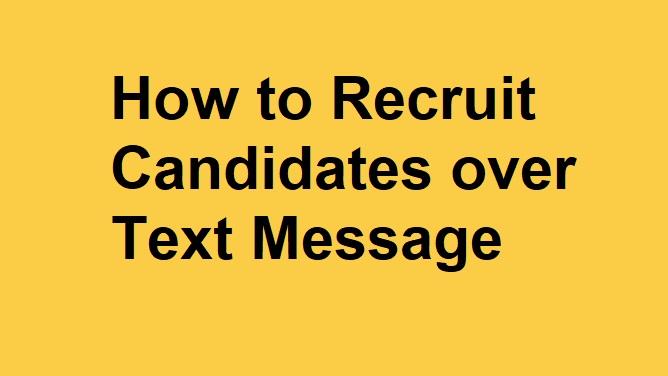
There are few people who would try to deny the convenience of texting. Whether you’re setting up a coffee date with a friend or, according to a recent survey, going through the hiring process, it’s many people’s preferred way of communicating. When it comes to those under 30, about 86% of young adults have positive feelings about using texts during the interview phase.
For recruiters, that means jumping on the texting bandwagon can help you snag top talent and make the candidate experience that much better just by catering to them in ways other companies may not be. Of course, some candidates may still consider texting to be of poor etiquette, so you’ll need to follow this advice to get good results. I would not recommend using a text as the first point of contact but rather as a follow up to a previous outreach engagement.
1. Ask Candidates What They Want
Texts can’t be ignored in the same way calls, voicemails, or even emails can be. That can make them a double-edged sword when you are communicating with any candidate. An unsolicited text can be inappropriate, which is the you must ask candidates if they’re open to using text as a form of communication.
Text messages can also lead to a sense of urgency or even imply an obligation to respond. For a candidate you’re trying to woo, you never want to seem pushy. So, before you even begin the interview process, ask candidates their preferred methods of communication and offer text as a form they could opt in to.
Try and stir the conversation and get to the point within one to two sentences at most. You will need to create trust within your message.
2. Sending a Warm Message
I recommend doing a cold reach out over Email or Inmail before trying to send a text message. A completely random “cold text” will not work. A text is a more personal way of communicating with individuals. I recommend outreaching to a lead in a different way before sending a text. Below are some examples:
After cold-calling:
Hey (Name), wanted to follow up with you over a text. I’m a recruiter at (company) and I’ve been trying to connect with you regarding your application to our role. When’s a good time to connect?
After emailing:
Hi (Name), I’ve been trying to connect with you. I’m a recruiter at (company) and was impressed by your experience and wanted to introduce myself. When’s a good time to connect?
After connecting on social media:
Hi (Name), we just connected on Twitter and I wanted to follow up with you. I’m a a recruiter at (company) and I’ve been impressed by your (tech skills). Would you be open to having a call?
2. Use Texts for Logistics
If a candidate is open to getting updates via text, you should use them as a way to figure out the logistics and send updates over time. For instance, text messages can be used to schedule an interview time or even give quick directions, acknowledge you received a document, or perhaps send a warm thank you after they leave an interview.
Here’s some examples:
Hi (Name) Here are directions to our office if you need them: [map url]. Let me know if you need anything before your interview tomorrow. I look forward to meeting you!
Hi (Name), we have a call scheduled for today. Just wanted to confirm if this time still works?
However, you shouldn’t use text messages for anything beyond this. Long messages should come via email or, best yet, a phone call to avoid miscommunications. Never text an essay, just short messages that are clear and concise.
3. Be Mindful of Timing
Being sensitive about what, when, and how you text is essential to success. That means you should never use text messages for the more delicate parts of the process, such as a rejection or job offer. And you also should be aware of when you send a text, no matter what that text is. Your texts should always be sent within business hours, or a job-seeker may just find you disrespectful. My hot spots for reaching out to leads over text has been between the hours of (10am-12pm) on weekdays.
When it comes to content, all text messages should be strictly related to their job hunt. After all, they didn’t opt-in to receive any other information, so stay on-topic.
4. Use the Right Tools
Just texting from your personal number like you would a good friend probably won’t cut it for the recruiting process. Chances are, you have a bunch of candidates to text, so it’s best to use tools to monitor and log conversations while keeping up with where each candidate is in the hiring process.
I recommend the tool called SimpleTexting. They offer free and paid versions within this tool. There’s a ton of other tools but I’ve used this one in the past and have had good success with it.
Receive and Reply to Messages
Our 2-way text messaging service makes it easy to strike up a conversation. Every plan comes with unlimited contacts, and all incoming SMS messages are free!
Schedule Automated Messages with Follow-ups
You can schedule a text message from your phone or even right from your computer. Simply compose the SMS message you want to send, select the recipients, and then assign a scheduled time for your message to be sent.
Connect with other Tools
Integrate within Google, Mailchimp, and Zaiper.
Track Analytics
SimpleTexting allows you to track your campaign performance with our built-in analytics tools. At a glance, you can see how many new subscribers you’ve gained, the number of users clicking links in your texts, and the number of messages sent per list.
Did you know there’s a hack to send text messages over email? Here’s how to do that trick (here).
Recommended Reading:
How to Build a Talent Pipeline Machine
How to Search and Find Layoff Lists Online
How to Search and Message Candidates on Facebook Messenger
- Unlocking the Power of Perplexity AI: Why Recruiters Should Utilize This Revolutionary Tool - February 11, 2024
- Exploring AI Interviewing Assessment Tools: A Comprehensive Review - November 30, 2023
- PartyRock a Sandbox for Talent Sourcing - November 29, 2023
